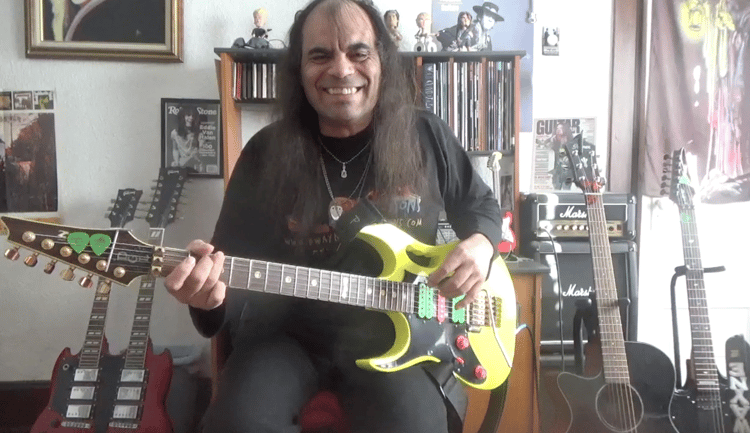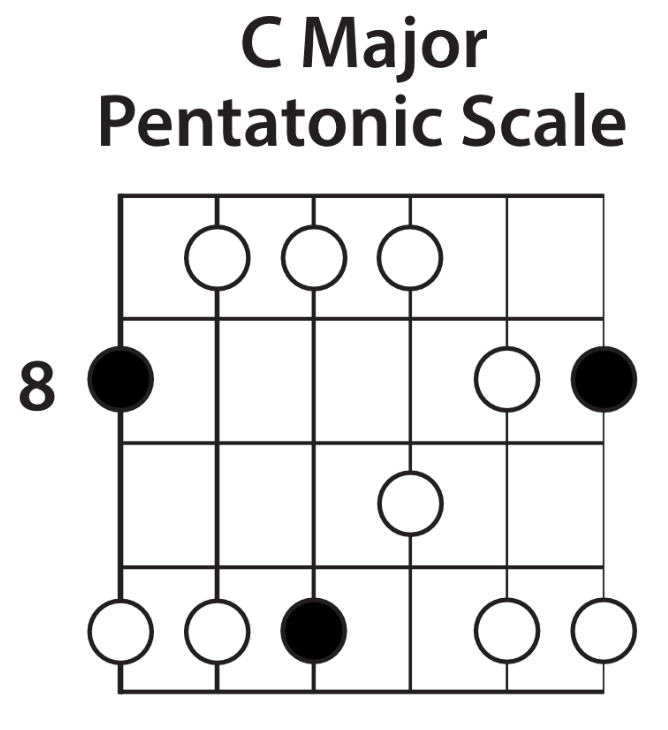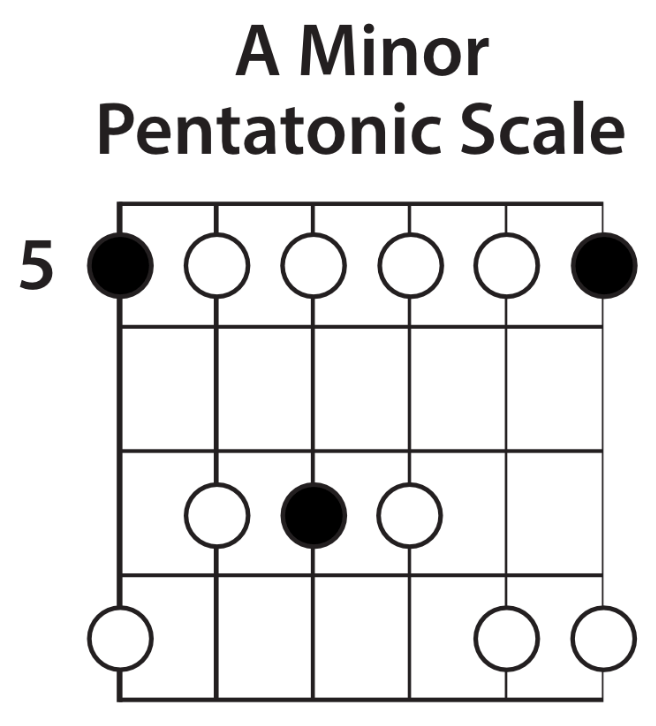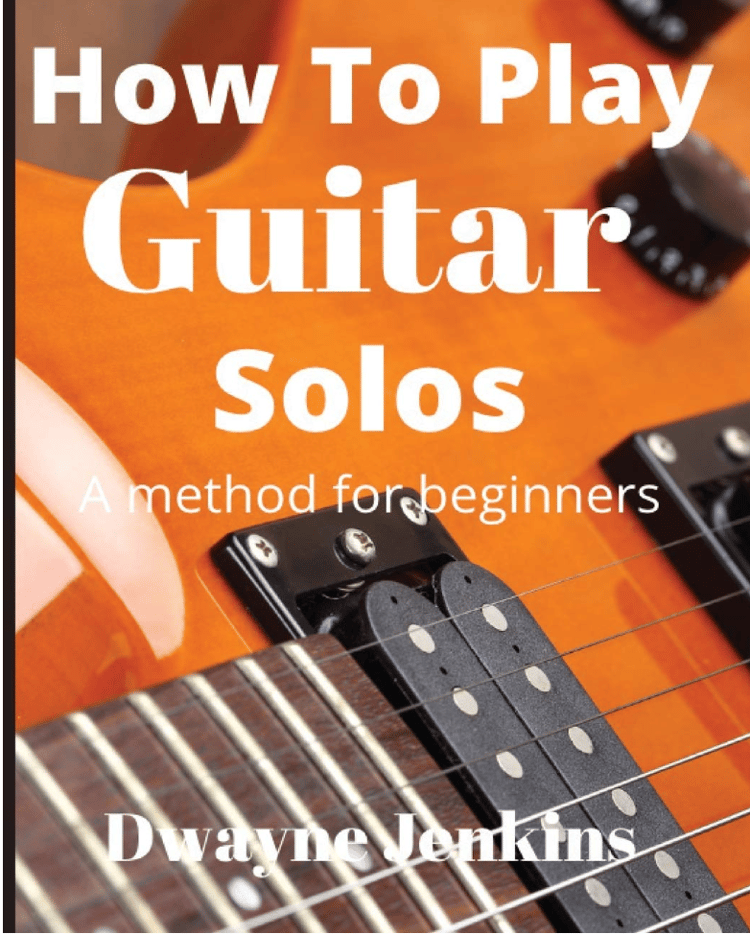In this lesson, we will learn why there are only five pentatonic patterns. We will unlock the mystery and discover the secret of the pentatonic scales.

The pentatonic scale
The pentatonic scale is very popular; it comprises 5 notes that come out of the major scale it is derived from. Why only 5 pentatonic scales? That is what pentatonic means. A scale of 5 notes. Penta means 5,
and tonic means tones or notes. With this in mind, we can create a Major pentatonic scale and a Minor pentatonic scale.
The major scale
In the regular major scale, the DO-Re-Mi, there are 8 notes. With the 1 and 8 being the same. Do Re Mi Fa So La Ti Do. But in reality, there are only 7 tones to the major scale because the 8th note that rounds it out is the first note in the second octave.
Out of these 8 notes, we use only 5 to play the pentatonic scale. Let’s look at this in further detail.
Key of C major: C D E F G A B C
If we take 5 specific notes out of the major scale, we can now create the major pentatonic scale. Although we now have two major scales, this scale will give us different shades of color. Which will help to expand our musical creativity.
C Major pentatonic: C D E G A = 1 2 3 5 6
As you can see, we have taken 5 notes out of the C Major scale to make the C Major pentatonic scale. Here is what this scale will look like played at the 8th fret. Why the 8th fret? Because that is where the C note resides on the fretboard on the 6th string.

We can also do this with a minor scale. It's the same concept, we take 5 notes from the minor to make the pentatonic. Let's look at this in more detail.
Key of A major: A B C# D E F# G# A
If we flatten the 3rd, 6th, and 7th notes, we get the A minor scale.
Key of A minor: A B C D E F G A
As you can see, we have flattened the 3rd and 7th notes of the A major scale. Now, we can take 5 notes out of this scale to create the A minor pentatonic scale. I chose this one to use as an example because it is the most common one, to begin with, that all guitar players use.
A minor pentatonic: A C D E G = 1 b3 4 5 b7

As you can see, the major pentatonic scale uses the 1 2 3 5 & 6th notes, and the minor pentatonic scale uses the 1 b3 4 5 & b7th notes. It is these note intervals that give these scales their emotional landscape. Major chords and scales have a happy sound, and minor chords and scales have a sad sound. Remember, music is all about creating emotion.
5 notes = 5 patterns
Since there are 5 notes in the scale, this creates 5 different patterns. A pattern is created from each note of the scale. So, a pattern will start at the A note, the C note, the D note, the E note, and the G note. Five notes equal five patterns.

When these notes line up across the fretboard, they create what is commonly known as “box patterns”. This gives the guitar player a nice visual roadmap to navigate the fretboard. If you learn to do this, you will not only be able to stay in key no matter where you play (no guessing), but you'll also be able to master the fretboard.
Unlocking the mystery & discovering the secret
Now that we know why only 5 pentatonic patterns and not 6 or 7 (because of the 5 notes in the scale), the secret to it is that these 5 notes repeat themselves over and over again. They also work with many different applications across many different styles of music.
They are also very easy to play once you get to know the pentatonic scale box pattern shapes. The one presented above is the most common and, usually, the one you learn first. So, I would take a look at this pattern and try playing it on your guitar.
Master the fretboard
Once you get it down, work with it. Play it up and down the fretboard. Play it back and forth. Do this over and over again until you know it like the back of your hand.
Once you know that, you can start using it for guitar riffs in rhythm as well as in solos. Then you can learn all 5 pentatonic patterns.

DIY but not by yourself
When it comes to playing the guitar and learning the 5 pentatonic patterns, you can do it yourself. Which a lot of guitar players do, and this option can be a lot of fun. You get to go at your own pace, you get to study and practice when it fits your schedule, and you get to learn in the comfort of your own home.
But this can be a bit distracting if you’re not traveling down a specific path. If you’re just learning a few things here and there, you will eventually get stuck in a rut. What you need is a path to travel on. A path that will get you there ASAP. Possibly a mentor, guiding hand, or a tour guide.
5 Pentatonic Scales Tour Guide
With the help of a guiding hand or a tour guide, you can get there much faster. Why? Because you can travel down a path that has already been blazed and proven to get you where you want to go.
Especially if you have a mentor who can teach you the tricks of the trade and keep you motivated to keep going when the going gets rough. That tour guide can be me. I can virtually help you through my method books. The book I authored and self-published.
How To Play Guitar Solos

How To Play Guitar Solos can teach you everything you need to know about the 5 pentatonic patterns and how to use them to play "Hot Rockin' Solos" in half the time it would take you to do it on your own because of its step-by-step system of learning. You just follow it one step at a time, with each lesson building upon itself. Before you know it, your friends are going, "Wow, how did you do that?"
You’ll learn such things as:
What scales to play
Where to play them along the fretboard
How to stay in key no matter where you play
How to improvise with confidence
How to understand music theory
How to read notation and diagrams
And much, much, more.
This book is jam-packed full of pictures and diagrams for easy learning. Even if you have no previous musical training. Even if you already know some things about playing guitar solos, you can still learn secret techniques that can take your guitar solos to the next level.
Final thoughts
Now, the 5 pentatonic patterns can not only be used for playing guitar solos but also for enhanced rhythm and guitar riffs. They are very popular, and everyone who plays guitar should learn them. They work with both major and minor keys and in multiple styles of music. They can benefit your guitar playing in more ways than one.
Private instruction is also available
If you feel you could also benefit from private one-on-one instruction, I offer that as well. I teach customized lessons that cater to your interests and skill level. This option can get you quicker results and a better understanding of techniques associated with playing the guitar. Just contact me at my website, and we can set up a time to talk on the phone.
Thanks for reading, and good luck with your guitar playing.
Until our next lesson, take care.
Sincerely, Dwayne Jenkins


